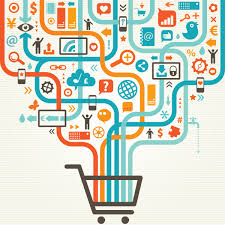Big data is a top trending buzzword. But, unlike overused buzzwords such as ‘omnichannel marketing’ or ‘growth hacking’, big data is very underhyped. According to IBM, 62% of retailers report that the use of big data is giving them a serious competitive advantage. Knowing what your customer wants and when they want it can be available at your fingertips with big data; all you need are the right tools and processes in place to make use of it. Let’s explore 7 innovative examples of big data personalization in retail for some inspiration.
Check out our previous article to see if you’re operating in one of the ten business areas that should be using big data already.
Macy’s: The Traditional Department Store is Ahead of Its Time
This upmarket department store has a long history of providing excellent customer service and has become a household name. Despite the heritage established since the first store opened in 1858, the brand has taken to the digital age like a fish to water.
Macy’s uses big data to offer a smarter customer experience. The brand analyzes multiple data points, such as stock levels and price promotions, and combines these findings with stock keeping unit data from a product at a particular location – as well as customer data – to ascertain which products are on sale in each store. This ensures that its chosen products suit the buying habits of customers in each location.
On top of this, Macy’s collects customer data ranging from visit frequency to style preference. This data is used to personalize the customer experience, offering incentives at the point of sale with loyalty rewards and promotions. This data also enables it to send targeted direct mail to its customers to boost conversions.
Amazon’s purchase recommendation engine

The ecommerce heavyweight Amazon has truly mastered its recommendation engine, but its functionality is actually quite simple. The algorithm is based on a user’s purchase history, the items they have in their cart already, items they have rated or liked in the past, and what other customers have viewed or purchased recently. In fact, it has been reported that over 35% of all Amazon sales are generated by the recommendation engine – a testament to the importance of product recommendations.
The primary reason for recommendation engine is to address the ‘long-tail problem’ – the fact that rare or obscure items are frequently not searched for, and therefore don’t drive revenue. By recommending long-tail items to shoppers, you can seriously drive the ROI potential of slower-moving ecommerce listings.
Kohl’s
Kohl’s is a brand with big data plans. This brand has recently suffered a decline in sales of 2.4%, along with decreased shopper traffic, and the brand’s CEO contemplated closing around 1,100 stores. However, in a change of heart, the brand has decided to implement new technologies to streamline its shopping experience and make stores smaller. To achieve this, it has invested over $2 billion in tech and big data initiatives. Product recommendations aside, the brand is on a mission to use big data firstly for the benefit of its customers, as well as to make the stores more profitable.
The entire online and physical shopping experience is personalized, from when a visitor lands on the homepage and is faced with deals and products on every page, to personalized offers that counter shopping cart abandonment. Kohl’s also uses its big data to create tailored marketing campaigns, which have been produced with customer data in mind. The brand now plans for data science to assist merchandising allocation, including external data like macro-economic conditions and social data, which will determine which products are stocked. This will ensure that products fly off the shelves faster.
Mall of America navigator chatbots
IBM has provided the Mall of America with a chatbot named E.L.F to assist shoppers navigating the vast complex. The Mall of America is in Bloomington, Minnesota, and it is the largest shopping complex in the northern states. It plays host to 520 retailers, 50 restaurants, 14 movie theaters, 2 hotels, an indoor theme park and a museum.
E.L.F. can create personalized shopping itineraries for each customer, finding the right experience for them (dependent on their needs). The chatbot is operated by a simple interface akin to a text messaging platform. E.L.F. is available via the Facebook Messenger app, the browser page, or kiosks in the Mall of America.
Nordstrom: fusing the online and offline shopping experience
This luxury retailer has mastered harnessing big data to fuse online and offline shopping experiences. Nordstom’s marketing team tracks Pinterest pins in order to identify which products are trending, and then employs this data to promote the right products in its physical stores.
Over 30% of Nordstrom’s budget is spent on technology, having established the ‘Nordstrom Innovation Lab’ based in Seattle for product development and testing. On top of this, Nordstrom hosts interactive touchscreens in changing rooms to allow customers to order products and view stock online.
TopShop
TopShop has been experimenting with new technologies to implement augmented reality into its shopping experience since 2010. Flagship stores have virtual fitting rooms where customers can select clothes to see how they would look wearing them on a screen. This saves the customer the time and effort of trying on clothes themselves.
In 2015, TopShop partnered with Twitter to analyze real time data on the social network, and identified trends as they happened during the five day London Fashion week event. These trends were grouped together on billboards using Twitter hashtags, so customers walking by would be encouraged to tweet a hashtag to their TopShop account indicating their favorite products. The fashion retailer then responded with a curated collection of the top picks.
This novel use of big data ensured that TopShop knew exactly what its customers were looking to buy following London Fashion Week.
IKEA
The Swedish interior giant IKEA featured image recognition and augmented reality for the first time when it showcased its 2013 catalog. Customers could scan through the catalog with their mobile devices to highlight products they were interested in, and from this, the brand offered personalized digital content and reviews to inform their purchase. The brand also used image-recognition technology, with which customers can scan catalog items and virtually place them in their own homes to see what they would look like. They can then select the colors and sizes that work best in the space, without having to actually go to store and purchase the product. This allowed the catalog readers to make informed purchases, resulting in higher customer satisfaction and fewer returned items.
These innovative uses of big data really enhance the customer experience, and have the potential to boost your sales. You don’t have to be a big player in retail to use big data. You could use it yourself to get ahead of your competitors, particularly if you use a Shopify storefront. This platform integrates with Blendo, a big data analytics plugin. Plugins and apps can be very useful ways for you to automatically collect and pull up data from multiple sources to inform your business decisions.
How will you integrate big data into your retail business? Have any of these examples inspired you? Let us know in the comments.










